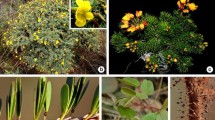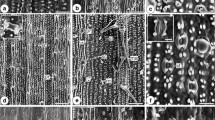Abstract
In this study we present a survey on vegetative anatomy in species of Actinocephalus, Blastocaulon, Eriocaulon, Leiothrix, Paepalanthus, Philodice, Syngonanthus, and Tonina (Eriocaulaceae). Multivariate analyses were used to correlate anatomical characters to taxa and the habitats where the species occur. Root and stem anatomical characters seem to be more affected by environmental factors where these species occur, and seem of little value for delimiting major taxonomic groups within the family. Other characters in the leaves, such as epidermis with thickened wall cells, compartmented substomatal chambers, mesophyll with hypodermis, compact chlorenchyma, collenchymatous bundle sheath extensions, and numerous vascular bundles, were shown to be important for defining species clusters in Leiothrix, Syngonanthus, and Paepalanthus subg. Platycaulon. Similarly, loosely aggregated chlorenchyma caused Blastocaulon, Eriocaulon, Philodice, Syngonanthus sect. Carpocephalus, S. sect. Syngonanthus, and Tonina, genera from humid environments, to cluster. Scape characters appear to be more informative in discriminating groups. This situation probably reflects lower selection pressures determining anatomical characters of this organ.
Similar content being viewed by others
Author information
Authors and Affiliations
Corresponding author
Rights and permissions
About this article
Cite this article
Scatena, V.L., Giulietti, A.M., Borba, E.L. et al. Anatomy of Brazilian Eriocaulaceae: correlation with taxonomy and habitat using multivariate analyses. Plant Syst. Evol. 253, 1–22 (2005). https://doi.org/10.1007/s00606-004-0295-z
Received:
Accepted:
Published:
Issue Date:
DOI: https://doi.org/10.1007/s00606-004-0295-z




